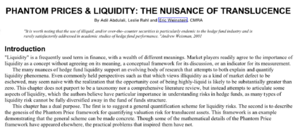Phantom Prices & Liquidity: The Nuisance Of Translucence
The 2002 article "Phantom Prices & Liquidity: The Nuisance of Translucence" by Adil Abdulali, Leslie Rahl, and Eric Weinstein, explores the complexities of measuring and quantifying liquidity, especially within hedge funds and other financial markets where liquidity is not always straightforward. It introduces the concept of the liquidity continuum, which ranges from highly liquid assets like U.S. Treasury bills to highly illiquid ones such as rare art or private real estate. The authors emphasize that liquidity and pricing are closely intertwined, with transparent markets enabling more accurate asset valuation compared to opaque ones. The paper challenges traditional valuation methods by addressing the limitations in pricing assets that are not frequently traded, proposing the Phantom Price framework as a novel approach for evaluating such "translucent" assets.
The authors present a four-step process for measuring illiquidity that includes reframing valuation questions, selecting relevant parameters, using distributional proxies, and employing statistical techniques. Additionally, the paper highlights how redemption restrictions in hedge funds contribute to liquidity risk and discusses the need for specialized metrics to account for these factors. By categorizing illiquidity into two main types—removable and intrinsic—the paper argues for a more nuanced understanding of liquidity risk and stresses the importance of recognizing and pricing these risks in investment strategies. Ultimately, the Phantom Price framework aims to provide a method for capturing the uncertainties in valuation, thus offering a way to assess risk and reward more effectively in less liquid markets.
Summary by SectionEdit
IntroductionEdit
The paper discusses the concept of "liquidity" in finance, acknowledging its various interpretations and roles as an indicator for market activity. It aims to address the nuances of liquidity, particularly in hedge funds, where liquidity risks are significant due to fund structure. The chapter proposes two objectives: to quantify liquidity risk and introduce the Phantom Price framework for valuing assets considered "translucent" in terms of liquidity.
Traditional Definitions and Examples of LiquidityEdit
The term "liquid" is defined traditionally as assets that can be quickly converted to cash, such as equities or U.S. Treasury bills. Illiquid assets, on the other hand, are harder to trade due to factors such as limited market depth or special transaction restrictions (e.g., real estate, corporate bonds). The liquidity continuum ranges from highly liquid assets like U.S. Treasury bills to highly illiquid ones like rare artwork or restricted securities.
Liquidity and Pricing – Two Sides of the Same CoinEdit
This section presents the idea that pricing and liquidity are interrelated. More transparent markets (with frequent trades) are easier to price than opaque markets (with infrequent trades). A table appears to illustrate the duality of liquidity and transparency, suggesting a spectrum from transparent, highly liquid assets to opaque, highly illiquid assets. The inclusion of convertible bonds in the "medium" category on this spectrum, rather than "high," is debated based on market experiences.
Measuring LiquidityEdit
Various views on illiquidity include seeing it as a defect, an opportunity for profit, or an inherent risk. Different measures for liquidity are discussed, including volume (traded units) and the bid-ask spread, which can indicate market depth and pricing accuracy. Volume may not always be a reliable measure due to factors like varied stock sizes and trading frequencies.
Bid-Ask SpreadEdit
The bid-ask spread is examined as a departure from the "one-price" model in some markets. The paper highlights how market participants often face wide bid-ask spreads, particularly for illiquid securities, leading to theoretical rather than actual transaction values.
Pricing LiquidityEdit
Challenges arise in pricing illiquid assets, even in seemingly efficient markets where prices should account for risk. The paper argues that large blocks of shares or controlling stakes in companies may not be fairly valued through simple market prices due to issues like reduced trading flexibility.
Four-Step Program: Valuation Framework for Quantifying LiquidityEdit
The paper proposes a systematic approach to address the valuation of assets along the liquidity spectrum:
- Transactions occur in varied conditions with different participants.
- Trading conditions affect asset pricing.
- Illiquid markets involve bid-ask spreads and manual adjustments by market-makers.
- Volume plays a critical role in valuation, with smaller trades typically providing more reliable pricing.
A Four-Step Framework for Measuring IlliquidityEdit
Step 1: Replace appraisal questions with specific valuation problems to account for liquidity-related factors. Step 2: Select parameters that reflect different aspects of illiquidity. Step 3: Use distributional proxies to represent valuation uncertainty. Step 4: Apply statistical methods to reduce distributional data into scalars that represent liquidity ratios.
Example: Phantom Price Framework for Translucent AssetsEdit
This section introduces the Phantom Price concept, a valuation framework for assets that are neither fully transparent nor opaque but lie somewhere in between. The framework uses multiple price observations to create a range of values, representing the inherent ambiguity in pricing such assets.
Redemption Restrictions in Hedge FundsEdit
Discusses how redemption policies and lock-up periods in hedge funds add another layer to liquidity risk. Hedge fund liquidity measurement must consider these restrictions, which often limit investors' ability to cash out during market disruptions.
ConclusionEdit
The paper categorizes illiquidity into two main types:
- Type A: Illiquidity arising from market imperfections that can potentially be mitigated.
- Type B: Intrinsic illiquidity that must be disclosed and factored into investment decisions.
It suggests that effectively measuring liquidity can lead to better risk management and investment strategies, advocating for frameworks like the Phantom Price to account for the complexities in valuing less liquid assets.
